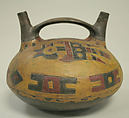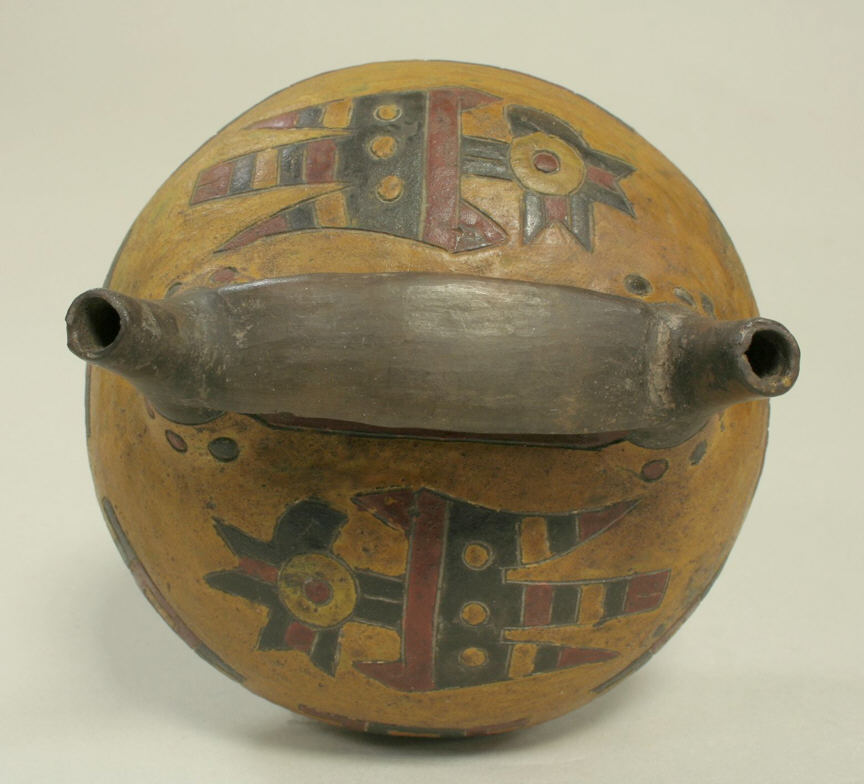Double Spout and Bridge Bottle
Not on view
A thick application of mustard-yellow paint on the body of this double-spout and bridge vessel provides a vivid backdrop for the red and green geometric and figural designs. Displayed parallel to the bridge of the vessel, two stylized birds extend lengthwise on either side of the vessel. The figures may represent an abstract raptor. The birds’ bodies are formally segmented with stamped circles and incised stripes with alternating red and green colors. Below the birds is a band of bracketed concentric-squares punctuated by a single concentric-diamond. Informal registers of figural and geometric decorations are often-used techniques in Paracas art. This vessel is from the Paracas culture of the south coast of Peru and dates between the 7th–5th century BC. Paracas affinity for symmetry and curvilinear forms is also apparent in their sophisticated textiles, as seen in textile fragments in the MMA collection, such as 33.149.24, which features similar stylized depictions of fauna to the double-spout and bridge vessel. Both art forms share iconography and coloration and were likely fundamental to Paracas ideology.
At the base of each stirrup spout, alternating red and black circles were reed-stamped. The burnished brown paint on the bridge and spouts of the vessel highlights their delicate quality. The double spout and bridge vessel form endured regionally on the south coast of Peru from the Paracas tradition through successive Andean cultures until European contact in the 16th century.
This type of spouted vessel may have been intended to hold liquids. The vessel’s form and elaborate decoration implies it was a special vessel, likely used in ceremonies and not for everyday use. Many Paracas double-spouted vessels of this type feature an internal construction that produces whistling sounds when liquids are poured.
The vessel body was shaped by hand, using a coiling technique to form the body’s shape. The body structure was then refined using a paddle-and-anvil. The bridge and spouts were shaped separately and later added to the body of the vessel. The bridge and spouts were hand-modeled or perhaps molded with tools such as small bones, perhaps a bird’s long bone. The vessel’s birds and geometric shapes were incised prior to firing, and colored paint was added afterwards. The Paracas tradition is well known for this technique called “post-fired painting”. The method involved an amalgam of ground mineral pigments mixed with a plant-resin binder to adhere the mineral pigments to the vessel. Although the Paracas potters also produced slip or pre-fired painted vessels, it is the post-fired painting technique that represents some of their most dynamic designs.
Paracas culture came to regional prominence during the 1st millennium BC. It was first documented archaeologically in 1925 by Julio Tello and Xesspe Mejia who carried out archaeological excavations at the Necropolis of Wari Kayan, located on the arid Paracas peninsula that juts into the Pacific, south of present-day Lima. Tello and Mejia excavated over 400 mummy bundles which were interred over the course of several hundred years. Commonly referred to as “mummy bundles,” the deceased individual’s body was placed sitting upright, in large baskets, along with funerary goods such as ceramics and jewelry. These baskets and individuals were then wrapped in multiple layers of richly decorated garments and textiles, sometimes numbering in the hundreds. The sack-like configuration of the mummy bundle was then interred in a shallow grave in the barren, desert landscape of the Paracas Pennisula. This double-spout and bridge vessel was likely part of one such assemblage.
Sarah Reetz, M.A. Candidate, Bard Graduate Center, 2017
References and Further Reading
DeLeonardis, Lisa. “Encoded Process, Embodied Meaning in Paracas Post-fired Ceramics” in Making Value, Making Meaning: Techné in the Pre-Columbian World, edited by Cathy Lynne Costin, pp. 129-166. Washington, D.C.: Dumbarton Oaks Research Library and Collections, 2016.
Deleonardis, Lisa "Interpreting the Paracas Body and its value in Ancient Peru". In The Construction of Value in The Ancient World, edited by John K. Papadopoulos and Gary Upton, pp. 197-217. Los Angeles: Cotsen Institute of Archaeology, UCLA, 2012.
Donnan, Christopher B. Ceramics of Ancient Peru. Los Angeles: Fowler Museum of Cultural History, University of California, 1992.
Easby, Elizabeth, “Notes." The Bulletin of the Metropolitan Museum of Art, 23, no. 5 (January), 1965.
Proulx, Donald A. A Sourcebook of Nasca Ceramic Iconography: Reading a Culture Through Its Art. 1st Edition. Iowa City: University of Iowa Press, 2006.
Proulx, Donald A "Paracas and Nasca: Regional Cultures on the South Coast of Peru" in Handbook of South American Archaeology, edited by Helaine Silverman and William Isbell, pp. 563-85. Springer Science & Business Media, 2008.
Sawyer, Alan and Nathan Cummings. Ancient Peruvian Ceramics: The Nathan Cummings Collection. New York: Metropolitan Museum of Art, 1966.
Stone-Miller, Rebecca. Art of the Andes : From Chavín to Inca , 3rd Edition. New York, N.Y: Thames & Hudson, 2012
Due to rights restrictions, this image cannot be enlarged, viewed at full screen, or downloaded.
This artwork is meant to be viewed from right to left. Scroll left to view more.



